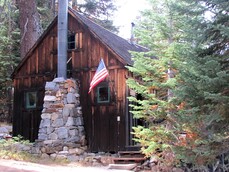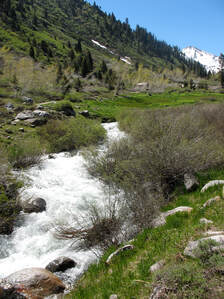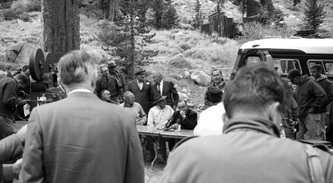|
My father considered a walk among the mountains as the equivalent of churchgoing." --- Aldous Huxley
“Mineral King is doubtless like other wonders of the Sierra Nevada . . . Those who hike it, fish it, hunt it, camp in it, or visit merely to sit in solitude and wonderment are legitimate spokesmen for it, whether they be few or many. Those who have that intimate relation with the inanimate object about to be injured, polluted, or otherwise despoiled are its legitimate spokesmen.”
---U.S. Supreme Court Justice William O. Douglas. “By this time most conscious people realize the incredibly delicate inter-relationships of the earth and its inhabitants. Like the human body, any abuse in any one part affects the whole system . . . [Therefore] we, the real owners of the public land, parks and forests, should not hesitate to help formulate general plans that affect the air, water and land by which we live.”
---Mineral King Planning Committee, an organization of cabin owners, 1972. “There are no better stewards of the environment than those who live in an area that the federal government is seeking to protect.” --- Jo Findaro, legislative advocate.
"Before these priceless bits of Americana (such as a valley, an alpine meadow, a river, or a lake) are forever lost or are so transformed as to be reduced to the eventual rubble of our urban environment, the voice of the existing beneficiaries of these environmental wonders should be heard.”
---U.S. Supreme Court Justice William O. Douglas. "A true conservative is a man who knows that the world is not given by his fathers, but borrowed from his children."
---John James Audubon “Eventually, all things merge into one, and a river runs through it.” --- Norman McLean
"It is here, in our lives, that we must come to know our essential connection to the wilder earth, because it is here, in the activity of our daily lives, that we most surely affect this earth, for good or ill." --- Lyanda Lynn Haupt
"Our public lands are lands held in trust for all of us. A certain responsibility goes with that, for the government, for the public at large, and for the people of the region. As for stewardship, or trust, we can see that the whole world is in the trust of humans now, whether we want this responsibility or not. The air and waters, the rivers, the deer and owls, the genetic health of all life are in our trust." --- Gary Snyder
Photos for this article by: Laurie Schwaller; and courtesy of Laurel DiSilvestro; Louise Jackson; Library of Congress, 2004671912; Mineral King Preservation Society; and Sequoia and Kings Canyon National Parks Archives
Plan Your Trip: https://www.nps.gov/seki/planyourvisit/vehicle-restrictions.htm
|
MINERAL KING Environment: Foothills, Mountains, National Park, historical and cultural landscape Activities: backpacking, birding, camping (Atwell Mill and Cold Springs), educational activities (historic structures, small visitor center/ranger station with displays, signage, interpretive walks and talks), hiking, photography, picnicking, fishing (license required) scenic views, wildlife viewing; food and lodging available at Silver City store and resort Open: daily (fee to enter National Park); road from Three Rivers to Mineral King is steep, narrow, and winding for 25 miles; drive cautiously and yield to oncoming traffic. Note: road is closed in winter. See Directions below. Site Stewards: Sequoia & Kings Canyon National Parks (SEKI), 559-565-3341; Mineral King Ranger Station (open only in summer), 559-565-3768; SEKI Wilderness Office, 559-565-3766; Mineral King District Association, Mineral King Preservation Society Opportunities for Involvement: donate, volunteer Links: plan your visit; Mineral King Road Cultural Landscape District listing on National Register; NPgallery.nps.gov/AssetDetail; Mineral King Preservation Society; Mineral King District Association; Sierra Nevada Geotourism; Sequoia Parks Conservancy; Walt Disney's Mineral King; Mineral King Webcam; Mineral King Road; Mineral King Road Rehabilitation Jim Hill Trip to Mineral King Books: 1) Mineral King: The Story Of Beulah by Louise A. Jackson, (Sequoia Natural History Association, 2006) 2) Challenge of the Big Trees: The Updated History of Sequoia and Kings Canyon National Parks, by William C. Tweed and Lary M. Dilsaver (George F. Thompson Publishing; Revised edition 2016) 3) Mineral King:Public Concern With Government Policy by John L. Harper (Pacifica Publishing, 1982) Directions: Map and directions are at the bottom of this page. History:
The Story of Mineral King by Louise Jackson Sometimes it takes more than an individual, organization, community, government agencies, or political and legal processes to preserve an important piece of our environment and human history. Sometimes it can take all of them. Even in 1863, when hunter Harry Parole discovered the pristine Mineral King Valley, the ravages of the Industrial Revolution and international commerce were beginning to show their effects across the nation. Still, it took decades for an awareness of mankind’s place in his environment to grow. By the 1930s conservation movements were forming throughout the world and Tulare County’s Mineral King Valley became a major landmark in the American conflict between commercial development and preservation of our mountain resources. By the end of World War II the Mineral King Valley had experienced three quarters of a century of exploitation by stockmen, miners, recreationists, and lumber and power company interests. Its small communities of Cabin Cove, Silver City, and the old mining town of Beulah had survived the governance, agendas and changing policies of several government agencies through constant adaptation and sometimes conflict. However, now the communities were in danger of extinction. Between 1945 and 1960, with the national economy and disposable wealth rapidly growing, both state and federal agencies were promoting increased commercial use of Sierra resources and the potential of a Mineral King Valley ski resort emerged. In 1946 Alf Engen, U.S. Olympic Ski Team coach, declared the valley to be the best ski country in the United States. A year later a winter survey team concurred with that assessment and in 1948 the Sierra Club, along with several other organizations, local communities and businesses, publicly backed a proposal for its recreational development. In response, the Sequoia National Forest issued a prospectus for a small winter sports complex, but no qualified bids were received. The narrow, winding dirt road into the valley proved too great a deterrent. Still, the dream continued. Several moneyed interests and ski enthusiasts including Luggi Foeger, Walt Disney, and Robert Brandt and his wife, actress Janet Leigh, visited the valley. The Brandts requested a re-opening of bids and in February of 1965 Sequoia National Forest issued a new prospectus for a huge multi-million dollar sports complex. This time, the agency received six bids, four of them far exceeding the prospectus requirements. It seemed the greatest ski area in the United States, or perhaps the world, was about to be born. At the same time, the national environmental movement was growing. In 1962 Rachel Carson’s Silent Spring was published. In 1963 and 1964 the first Clean Air Act and the Wilderness Preservation Act were passed. When the scope of the Mineral King project was publicized, the proposed “rape” of such a pristine Sierra valley became a national issue. In March of 1965 the Sierra Club once again released a statement backing the concept of a Mineral King ski area, but two months later its members voted to oppose it. That summer the Mineral King community formed the Mineral King District Association to resist planned destruction of its three cabin enclaves. When Disney’s WED Corporation won the bid in December, the Sierra Club led a fight by the District Association and several other organizations to stop the immense $35 million development. In 1966 the National Park Service became involved when it held a hearing on wilderness designation along its portion of the Mineral King Road. In spite of the increasing opposition, the Forest Service and Disney Corporation forged ahead. By 1968, with several years of research, development of a master plan, and state funding lined up for an all-season road, the resort appeared to be an accomplished fact. However, the next year the Sierra Club won an injunction against the building and maintenance of the planned all-season highway and a ten-year journey through the nation’s district and federal court system began. Finally, the lawsuit reached the Supreme Court of the United States. On April 19, 1972, the Supreme Court, by a vote of four to three, rendered its decision. The Sierra Club could not show that the club itself would suffer economic or other injury from development of the valley so it lacked standing to sue. It was a landmark decision. Not because it seemed big business interests had won, but because of the dissenting opinion of Justice William O. Douglas, which asserted that environmental well-being is as important as economic well-being and that entities as well as individuals may sue if they can show direct cause for harm. That opinion would help guide and motivate the forces for conservation throughout the nation and the world for years to come. Planning resumed for the Disney resort, but on a smaller scale. At the same time, another long-contemplated solution to protect Mineral King’s historic and natural character took shape. California Congressman Phillip Burton was helping to craft an “omnibus” bill redefining the management of nearly one hundred national scenic areas, trails and rivers. In conjunction, California Congressman John Krebs also wrote a bill to include Mineral King’s transfer to Sequoia National Park in the omnibus bill and President Jimmy Carter agreed to support it. On October 12, 1978, the bill passed. Once again, Mineral King faced the challenge of management by another agency and, while no ski resort could be built, the new law still called for eventual termination of the cabin communities. In 1982, Sequoia and Kings Canyon National Parks completed a cultural resources plan in which the 113-year-old Mineral King cabin community was not included. Also, as cabin owners of record began to die, the 1978 legal mandate to remove those cabins became reality, and community member Ora Kay Peterson became alarmed. In the summer of 1986 she invited a few other concerned people to her cabin and the Mineral King Preservation Society was born. Its key goal was to preserve mankind’s historic role in his natural surroundings, specifically in the Mineral King Valley. For seventeen years, Ora Kay led a comprehensive program of surveying, mapping, and recording historic sites; setting up a repository and display for historic writings, photos, and artifacts; restoring the last remaining original resort cabin; funding a written history of the valley; and most critical, working toward listing the historic district on the National Register of Historic Places. The state and national process of gaining National Register listing dragged through the next eleven years. Finally, while in the midst of creating a new park general management plan, Sequoia and Kings Canyon Park officials decided to proceed with their own nomination. Six more years passed before National Register listing was at last achieved, but there was still one caveat. The Mineral King Road Cultural Landscape District would preserve the historic nature of the road and communities, but the law still said the cabins could be removed. It required one final effort to preserve the historic valley. This time it was the Mineral King District Association that took the lead. Members John Crowe and Kathy Hath spearheaded the effort with a San Francisco environmental law attorney, a congressional lobbyist, and young California Congressman Devin Nunes. Nunes wrote a bill amending the 1978 legislation to grant the Mineral King summer homeowners and their “heirs, successors and assigns” the right to continue ownership in perpetuity of their privately owned cabins on lands leased from the park. President George W. Bush signed the bill into law on December 8, 2004, and the Mineral King communities continued their time-honored role as conservators of the Mineral King Valley’s unique history. Today the National Park Service, Mineral King Preservation Society, and Mineral King District Association work together to assure the historic integrity of the valley’s communities and the natural resources surrounding them. June, 2013 Directions:
Address: Mineral King, Sequoia National Park Location Coordinates: WGS84 36° 16′ 13.08″ N, 118° 21′ 14.76″ W 36.2703, -118.3541 UTM 11S 378373 4014780 Take Hwy 198 east from Visalia (A) through Three Rivers (B) to sign for Sequoia National Park and Mineral King; turn right onto Mineral King Road. Stay left on Mineral King Road at the junction with Hammond Road. There is an NPS self-service fee station at Lookout Point about 12-13 miles up the road. The road is steep, narrow, and winding for 25 miles; drive cautiously and yield to oncoming traffic; wide vehicles are not recommended. Note: Mineral King road is closed below Lookout Point during the winter. Road is open all the way to Mineral King Valley usually Memorial Day to mid-October depending on weather. RVs and trailers are not recommended. Call 559-565-3341, (then press 1, 1, 1) for road status and advisories. MINERAL KING WEBCAM LINK |















